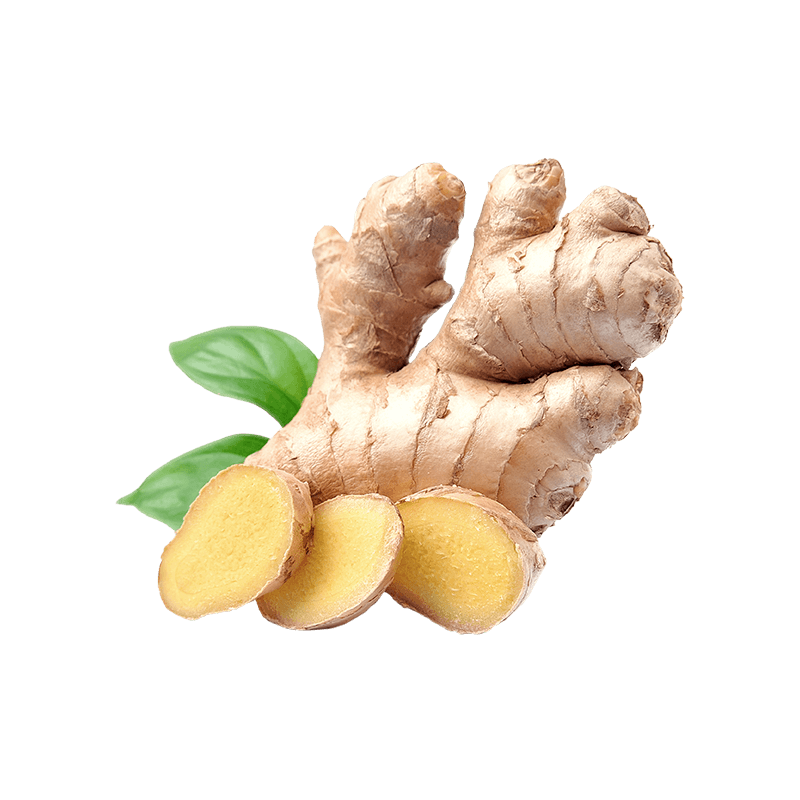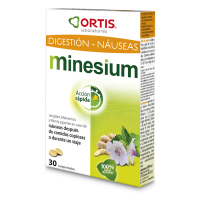
Jengibre
Planta vivaz tropical y herbácea, con una altura aproximada de 0,90 m, que se desarrolla a partir de un rizoma. Hojas persistentes lanceoladas, biseriadas, largas y olorosas. Flores blancas y amarillas, con puntos rojos en los labios y con brácteas verdes y amarillas. Una espiga axilar corta, que contiene semillas negras encapsuladas, aparece después de la floración en el extremo de un tallo cubierto de escamas.
Nombre latino
Origen
Asia.
Parte utilzada
Los rizomas.
Ingredientes activos
Oleorresina: responsable del picor al consumirlo, pero también del efecto antiemético y digestivo.
Uso
El jengibre se utiliza frecuentemente como especia en la cocina y también se puede encontrar en diversas mezclas de especias. Tiene un sabor típico y apetitoso. Es un ingrediente esencial de la cocina asiática, donde se utiliza para preparar platos muy sazonados y también en pastelería. La raíz se puede confitar para elaborar dulces.
El ginger ale es una bebida gaseosa refrescante hecha con jengibre. Procedente de Surinam, el ginger ale es popular en la actualidad porque no contiene alcohol pero tiene un sabor bastante fuerte.
El jengibre tiene una larga historia de uso medicinal en la medicina china tradicional y ayurvédica. Se ha utilizado para estimular la libido y la vitalidad, pero también para tratar los mareos en los medios de transporte, las náuseas, los trastornos digestivos y las inflamaciones.
La investigación científica sobre el jengibre demuestra que esta planta es rica en antioxidantes 1-7 y que presenta propiedades inmunomoduladoras. 8-18
Referencias bibliográficas
- Effects of 6-gingerol, an antioxidant from ginger, on inducing apoptosis in human leukemic HL-60 cells.
In Vivo. 2003 Nov-Dec;17(6):641-5.
Wang CC, Chen LG, Lee LT, Yang LL.
Pubmed: http://www.ncbi.nlm.nih.gov/pubmed/14758732 - 6-shogaol-rich extract from ginger up-regulates the antioxidant defense systems in cells and mice.
Bak MJ, Ok S, Jun M, Jeong WS.
Molecules. 2012 Jul 4;17(7):8037-55.
Pubmed: http://www.ncbi.nlm.nih.gov/pubmed/22763741 - 10-Shogaol, an Antioxidant from Zingiber officinale for Skin Cell Proliferation and Migration Enhancer.
Chen CY, Cheng KC, Chang AY, Lin YT, Hseu YC, Wang HM.
Int J Mol Sci. 2012;13(2):1762-77.
Pubmed: http://www.ncbi.nlm.nih.gov/pubmed/22408422 - In vitro antioxidant and anticancer activity of young Zingiber officinale against human breast carcinoma cell lines.
Rahman S, Salehin F, Iqbal A.
BMC Complement Altern Med. 2011 Sep 20;11:76.
Pubmed: http://www.ncbi.nlm.nih.gov/pubmed/21933433 - Anti-inflammatory and anti-oxidant properties of Curcuma longa (turmeric) versus Zingiber officinale (ginger) rhizomes in rat adjuvant-induced arthritis.
Ramadan G, Al-Kahtani MA, El-Sayed WM.
Inflammation. 2011 Aug;34(4):291-301
Pubmed: http://www.ncbi.nlm.nih.gov/pubmed/21120596 - Protective effects of dietary ginger (Zingiber officinales Rosc.) on lindane-induced oxidative stress in rats.
Ahmed RS, Suke SG, Seth V, Chakraborti A, Tripathi AK, Banerjee BD.
Phytother Res. 2008 Jul;22(7):902-6.
Pubmed: http://www.ncbi.nlm.nih.gov/pubmed/18389491 - Antioxidant properties of gingerol related compounds from ginger.
Masuda Y, Kikuzaki H, Hisamoto M, Nakatani N.
Biofactors. 2004;21(1-4):293-6.
Pubmed: http://www.ncbi.nlm.nih.gov/pubmed/15630214 - In vitro immunomodulatory effects of ten commonly used herbs on murine lymphocytes.
Wilasrusmee C, Kittur S, Siddiqui J, Bruch D, Wilasrusmee S, Kittur DS.
J Altern Complement Med. 2002 Aug;8(4):467-75.
Pubmed: http://www.ncbi.nlm.nih.gov/pubmed/12230907 - Immunosuppressive activity of 8-gingerol on immune responses in mice.
Lu J, Guan S, Shen X, Qian W, Huang G, Deng X, Xie G.
Molecules. 2011 Mar 22;16(3):2636-45.
Pubmed: http://www.ncbi.nlm.nih.gov/pubmed/21441866 - Repeated oral administration of a squeezed ginger (Zingiber officinale) extract augmented the serum corticosterone level and had anti-inflammatory properties.
Ueda H, Ippoushi K, Takeuchi A.
Biosci Biotechnol Biochem. 2010;74(11):2248-52.
Pubmed: http://www.ncbi.nlm.nih.gov/pubmed/21071834 - Immunomodulatory activity of Zingiber officinale Roscoe, Salvia officinalis L. and Syzygium aromaticum L. essential oils: evidence for humor- and cell-mediated responses.
Carrasco FR, Schmidt G, Romero AL, Sartoretto JL, Caparroz-Assef SM, Bersani-Amado CA, Cuman RK.
J Pharm Pharmacol. 2009 Jul;61(7):961-7.
Pubmed: http://www.ncbi.nlm.nih.gov/pubmed/19589240 - TBK1-targeted suppression of TRIF-dependent signaling pathway of Toll-like receptors by 6-shogaol, an active component of ginger.
Park SJ, Lee MY, Son BS, Youn HS.
Biosci Biotechnol Biochem. 2009 Jul;73(7):1474-8.
Pubmed: http://www.ncbi.nlm.nih.gov/pubmed/19584560 - Inhibition of homodimerization of toll-like receptor 4 by 6-shogaol.
Ahn SI, Lee JK, Youn HS.
Mol Cells. 2009 Feb 28;27(2):211-5.
Pubmed: http://www.ncbi.nlm.nih.gov/pubmed/19277504 - Ginger prevents Th2-mediated immune responses in a mouse model of airway inflammation.
Ahui ML, Champy P, Ramadan A, Pham Van L, Araujo L, Brou André K, Diem S, Damotte D, Kati-Coulibaly S, Offoumou MA, Dy M, Thieblemont N, Herbelin A.
Int Immunopharmacol. 2008 Dec 10;8(12):1626-32.
Pubmed: http://www.ncbi.nlm.nih.gov/pubmed/18692598 - Ginger extract inhibits LPS induced macrophage activation and function.
Tripathi S, Bruch D, Kittur DS.
BMC Complement Altern Med. 2008 Jan 3;8:1.
Pubmed: http://www.ncbi.nlm.nih.gov/pubmed/18173849 - Evaluation of Ginger (Zingiber officinale Roscoe) Bioactive Compounds in Increasing the Ratio of T-cell Surface Molecules of CD3+CD4+:CD3+CD8+ In-Vitro.
Tejasari D.
Malays J Nutr. 2007 Sep;13(2):161-70.
Pubmed: http://www.ncbi.nlm.nih.gov/pubmed/22691754 - Macrophage-mediated inhibitory effect of Zingiber officinale Rosc, a traditional oriental herbal medicine, on the growth of influenza A/Aichi/2/68 virus.
Imanishi N, Andoh T, Mantani N, Sakai S, Terasawa K, Shimada Y, Sato M, Katada Y, Ueda K, Ochiai H.
Am J Chin Med. 2006;34(1):157-69.
Pubmed: http://www.ncbi.nlm.nih.gov/pubmed/16437748 - The modulatory effects of the volatile oil of ginger on the cellular immune response in vitro and in vivo in mice.
Zhou HL, Deng YM, Xie QM.
J Ethnopharmacol. 2006 Apr 21;105(1-2):301-5.
Pubmed: http://www.ncbi.nlm.nih.gov/pubmed/16338110
Las declaraciones de propiedades saludables relativas a las plantas que contienen los productos que figuran en nuestro sitio web son conformes a la lista de declaraciones de propiedades saludables en espera de evaluación definitiva por parte de las autoridades comunitarias (véase el sitio web de la Comisión Europea: http://ec.europa.eu/nuhclaims/). Sin embargo, pueden sufrir modificaciones tras su evaluación por las autoridades nacionales competentes.
Las declaraciones de propiedades saludables relativas a otros nutrientes o sustancias que contienen los productos que figuran en nuestro sitio web son conformes al Reglamento n.º 432/2012 de la Comisión, de 16 de mayo de 2012, por el que se establece una lista de declaraciones autorizadas de propiedades saludables de los alimentos distintas de las relativas a la reducción del riesgo de enfermedad y al desarrollo y la salud de los niños (véase el sitio web de la Comisión Europea: http://ec.europa.eu/nuhclaims/).

 Belgique
Belgique  België
België  France
France  Italia
Italia  Portugal
Portugal  España
España  United Kingdom
United Kingdom  Κύπρος
Κύπρος 
